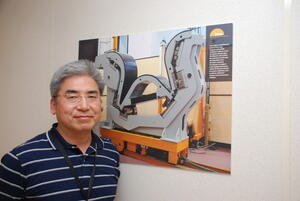Collaborating for fusion
Working in an international setting is nothing new for Michiya Shimada—thirty-four years of involvement in fusion research projects have made him quite at home on three continents.
Michiya participated in the groundbreaking work carried out in divertor physics at the Doublet-III experiment in San Diego, California in the early 1980s. He was one of the younger scientists at the time: he had an engineering degree from the University of Tokyo in his pocket, and was working toward his PhD. "At Doublet-III, we discovered that divertor plasmas can become very cold, highly radiative, and denser than the core plasmas in tokamaks," Shimada recounts, looking back. "This had great importance for three reasons: radiative dissipation allows us to limit the heat load on the divertor, reduce erosion of divertor materials, and enable an efficient removal of helium ash."
Divertor physics was to remain the predominant focus for Shimada. From 1989 on, he continued work on divertor concepts at the JT-60U Tokamak in Naka, Japan. He also chaired the Divertor Database and Modelling Expert Group, organized for ITER physics R&D. "At the time, we were confident that ITER would happen scientifically, but there were not yet any political guarantees," Shimada remembers. "I felt optimistic, though, and joined the ITER team in 1999." When the ITER Agreement set the project into motion, making the move to ITER site was the logical next step in his career. Shimada was among the first Cadarache recruits for ITER, arriving at the Joint Work Site in December 2006. His wife and ten year-old son joined him one year later; the family is now settled in Manosque.
At ITER, Michiya Shimada is Chief Scientific Officer for the Plasma Wall Interaction Group in the Fusion Science & Technology Department. The challenges are great and the hours are long. Shimada also co-chairs the Coordinating Committee for the International Tokamak Physics Activity (ITPA), an international framework that plays an instrumental role in focusing worldwide physics efforts on physics issues for ITER that need further investigation. "Fusion research is necessarily an international endeavor; the stakes are high and no one nation can manage the investment alone. We need input from fusion work done all over the world to reach our goal of producing energy from fusion faster," explains Shimada.
Although it may seem hard to imagine, Shimada has found time to pursue a second passion throughout the years—one that he was able to share with his ITER colleagues during last June's Music Festival. He is an accomplished singer, with a particular interest in classical repertoire. He is currently working toward recording Robert Schumann's Dichterliebe, accompanied on the piano by another ITER musician, Philip Andrew from Diagnostics.


